2019 Hyundai Santa Fe wheel
[x] Cancel search: wheelPage 320 of 682
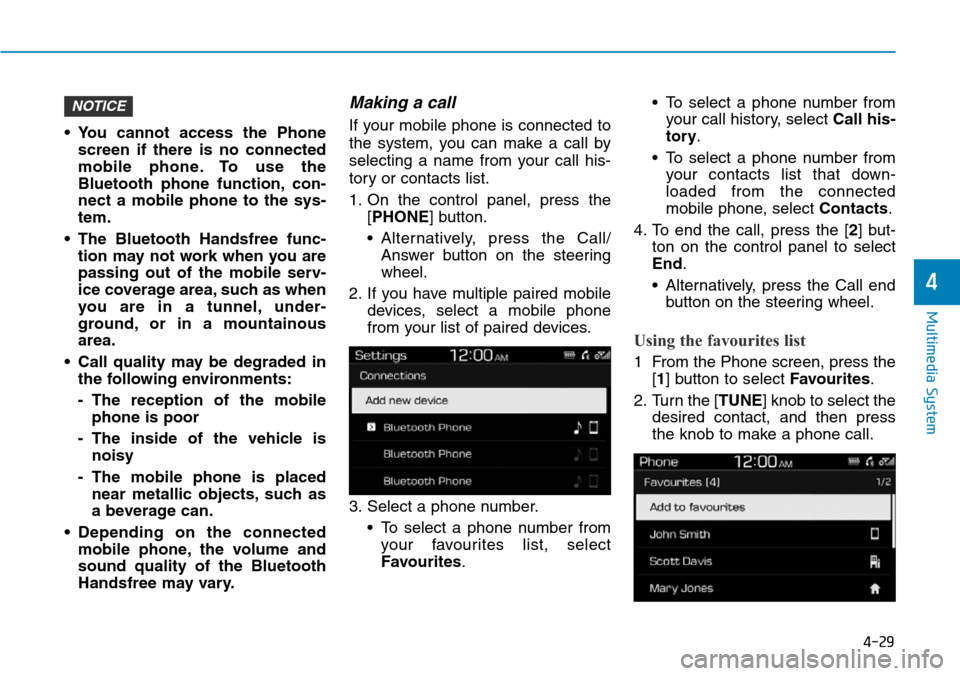
4-29
Multimedia System
4
• You cannot access the Phone
screen if there is no connected
mobile phone. To use the
Bluetooth phone function, con-
nect a mobile phone to the sys-
tem.
• The Bluetooth Handsfree func-
tion may not work when you are
passing out of the mobile serv-
ice coverage area, such as when
you are in a tunnel, under-
ground, or in a mountainous
area.
• Call quality may be degraded in
the following environments:
- The reception of the mobile
phone is poor
- The inside of the vehicle is
noisy
- The mobile phone is placed
near metallic objects, such as
a beverage can.
• Depending on the connected
mobile phone, the volume and
sound quality of the Bluetooth
Handsfree may vary.
Making a call
If your mobile phone is connected to
the system, you can make a call by
selecting a name from your call his-
tory or contacts list.
1. On the control panel, press the
[PHONE] button.
• Alternatively, press the Call/
Answer button on the steering
wheel.
2. If you have multiple paired mobile
devices, select a mobile phone
from your list of paired devices.
3. Select a phone number.
• To select a phone number from
your favourites list, select
Favourites.• To select a phone number from
your call history, select Call his-
tory.
• To select a phone number from
your contacts list that down-
loaded from the connected
mobile phone, select Contacts.
4. To end the call, press the [2] but-
ton on the control panel to select
End.
• Alternatively, press the Call end
button on the steering wheel.
Using the favourites list
1 From the Phone screen, press the
[1] button to select Favourites.
2. Turn the [TUNE] knob to select the
desired contact, and then press
the knob to make a phone call.
NOTICE
Page 323 of 682
![Hyundai Santa Fe 2019 Owners Manual - RHD (UK, Australia) 4-32
Multimedia System
To answer the call, press the [1] but-
ton on the control panel to select
Accept.
• Alternatively, press the Call/
Answer button on the steering
wheel.
To reject the call, pre Hyundai Santa Fe 2019 Owners Manual - RHD (UK, Australia) 4-32
Multimedia System
To answer the call, press the [1] but-
ton on the control panel to select
Accept.
• Alternatively, press the Call/
Answer button on the steering
wheel.
To reject the call, pre](/manual-img/35/16317/w960_16317-322.png)
4-32
Multimedia System
To answer the call, press the [1] but-
ton on the control panel to select
Accept.
• Alternatively, press the Call/
Answer button on the steering
wheel.
To reject the call, press the [2] button
on the control panel to select Reject.
• Alternatively, press the Call end
button on the steering wheel.
• Depending on the mobile phone
type, call rejection may not be
supported.
• Once your mobile phone is con-
nected to the system, the call
sound may be output through
the vehicle’s speakers even after
you exit the vehicle if the phone
is within the connection range.
To end the connection, discon-
nect the device from the system
or deactivate Bluetooth on the
device.
Using options during a call
During a call, you will see the call
screen shown below. Press a button
to perform the function you want.
To switch the call to your mobile
phone, press the [1] button on the
control panel to select Private.
• Alternatively, press and hold the
Call/Answer button on the steering
wheel.
To end the call, press the [2] button
on the control panel to select End.
• Alternatively, press the Call end
button on the steering wheel.
Press the [MENU] button on the con-
trol panel to access the following
menu options:•Microphone Volume(Outgoing
Volume): Adjust the microphone
volume or turn off the microphone
so the other party cannot hear you.
• If the caller information is saved
in your contacts list, the caller’s
name and phone number will be
displayed. If the caller informa-
tion is not saved in your con-
tacts list, only the caller’s phone
number will be displayed.
• You cannot switch to any other
screen, such as the audio
screen or the settings screen,
during a Bluetooth call.
• Depending on the mobile phone
type, call quality may vary. On
some phones, your voice may be
less audible to the other party.
• Depending on the mobile phone
type, the phone number may not
be displayed.
• Depending on the mobile phone
type, the call switching function
may not be supported.
NOTICE
NOTICE
Page 330 of 682
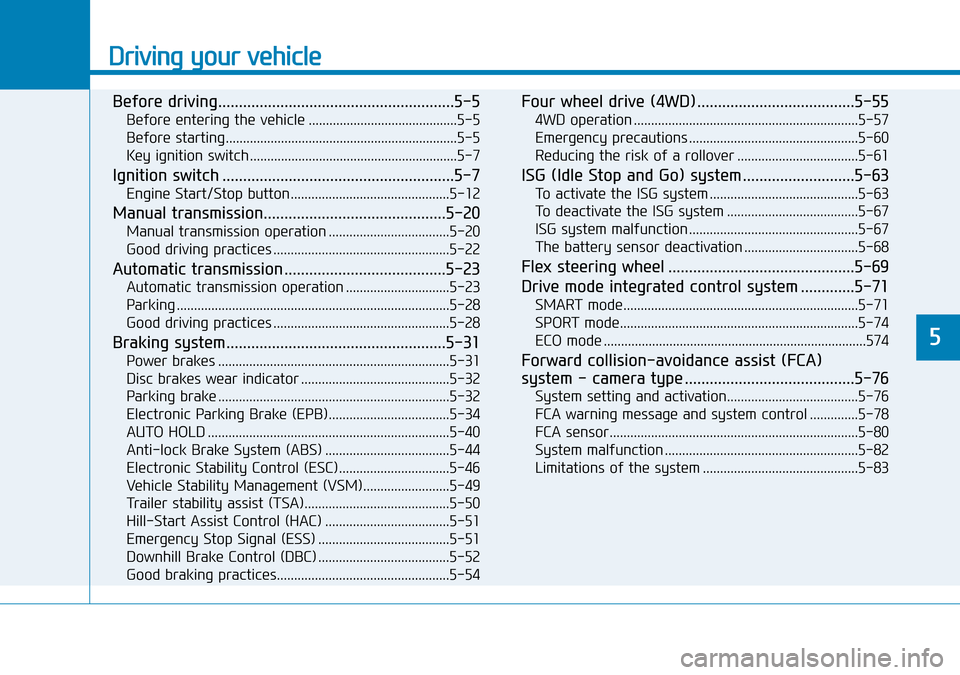
Driving your vehicle
Before driving.........................................................5-5
Before entering the vehicle ...........................................5-5
Before starting...................................................................5-5
Key ignition switch ............................................................5-7
Ignition switch ........................................................5-7
Engine Start/Stop button ..............................................5-12
Manual transmission............................................5-20
Manual transmission operation ...................................5-20
Good driving practices ...................................................5-22
Automatic transmission .......................................5-23
Automatic transmission operation ..............................5-23
Parking ...............................................................................5-28
Good driving practices ...................................................5-28
Braking system.....................................................5-31
Power brakes ...................................................................5-31
Disc brakes wear indicator ...........................................5-32
Parking brake ...................................................................5-32
Electronic Parking Brake (EPB)...................................5-34
AUTO HOLD ......................................................................5-40
Anti-lock Brake System (ABS) ....................................5-44
Electronic Stability Control (ESC)................................5-46
Vehicle Stability Management (VSM).........................5-49
Trailer stability assist (TSA)..........................................5-50
Hill-Start Assist Control (HAC) ....................................5-51
Emergency Stop Signal (ESS) ......................................5-51
Downhill Brake Control (DBC) ......................................5-52
Good braking practices..................................................5-54
Four wheel drive (4WD) ......................................5-55
4WD operation .................................................................5-57
Emergency precautions .................................................5-60
Reducing the risk of a rollover ...................................5-61
ISG (Idle Stop and Go) system ...........................5-63
To activate the ISG system ...........................................5-63
To deactivate the ISG system ......................................5-67
ISG system malfunction .................................................5-67
The battery sensor deactivation .................................5-68
Flex steering wheel .............................................5-69
Drive mode integrated control system .............5-71
SMART mode....................................................................5-71
SPORT mode.....................................................................5-74
ECO mode ............................................................................574
Forward collision-avoidance assist (FCA)
system - camera type .........................................5-76
System setting and activation......................................5-76
FCA warning message and system control ..............5-78
FCA sensor........................................................................5-80
System malfunction ........................................................5-82
Limitations of the system .............................................5-83
5
Page 334 of 682

5-5
Driving your vehicle
5
Before entering the vehicle
• Be sure all windows, outside mir-
ror(s), and outside lights are clean
and unobstructed.
• Remove frost, snow, or ice.
• Visually check the tyres for uneven
wear and damage.
• Check under the vehicle for any
sign of leaks.
• Be sure there are no obstacles
behind you if you intend to back up.
Before starting
• Make sure the bonnet, the tailgate,
and the doors are securely closed
and locked.
• Adjust the position of the seat and
steering wheel.
• Adjust the inside and outside
rearview mirrors.
• Verify all the lights work.
• Fasten your seat belt. Check that
all passengers have fastened their
seat belt.
• Check the gauges and indicators in
the instrument panel and the mes-
sages on the instrument display
when the ignition switch is in the
ON position.
• Check that any items you are car-
rying are stored properly or fas-
tened down securely.
BEFORE DRIVING
To reduce the risk of SERIOUS
INJURY or DEATH, take the fol-
lowing precautions:
•ALWAYS wear your seat belt.
All passengers must be prop-
erly belted whenever the vehi-
cle is moving. For more infor-
mation, refer to "Seat Belts" in
chapter 2.
•Always drive defensively.
Assume other drivers or pedes-
trians may be careless and
make mistakes.
•Stay focused on the task of
driving. Driver distraction can
cause accidents.
•Leave plenty of space between
you and the vehicle in front of
you.
WARNING
Page 336 of 682
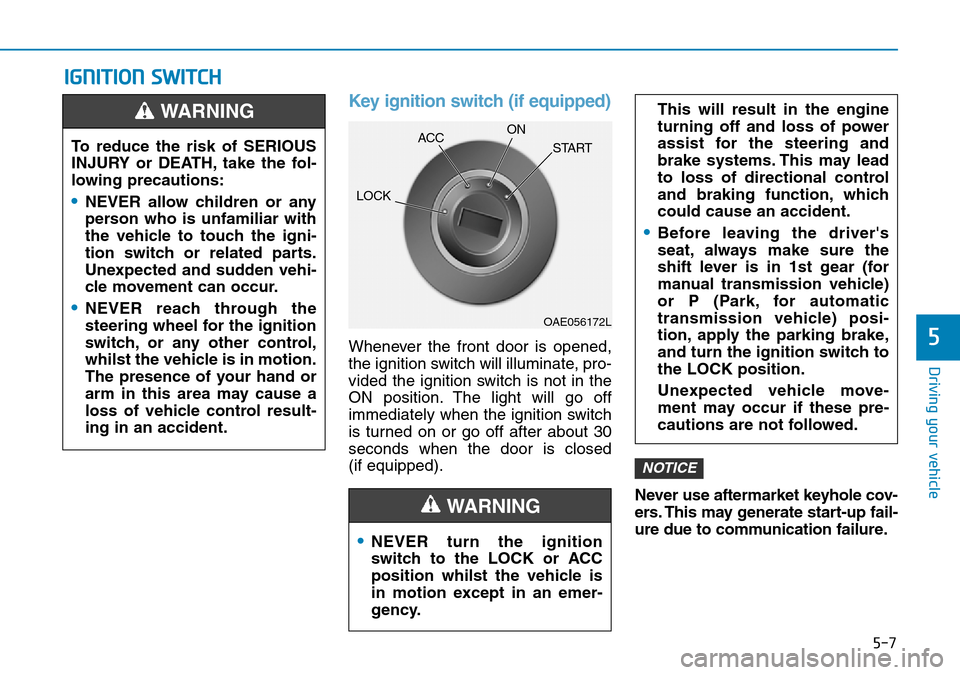
5-7
Driving your vehicle
5
IGNITION SWITCH
Key ignition switch (if equipped)
Whenever the front door is opened,
the ignition switch will illuminate, pro-
vided the ignition switch is not in the
ON position. The light will go off
immediately when the ignition switch
is turned on or go off after about 30
seconds when the door is closed
(if equipped).
Never use aftermarket keyhole cov-
ers. This may generate start-up fail-
ure due to communication failure.
NOTICE
•NEVER turn the ignition
switch to the LOCK or ACC
position whilst the vehicle is
in motion except in an emer-
gency.
This will result in the engine
turning off and loss of power
assist for the steering and
brake systems. This may lead
to loss of directional control
and braking function, which
could cause an accident.
•Before leaving the driver's
seat, always make sure the
shift lever is in 1st gear (for
manual transmission vehicle)
or P (Park, for automatic
transmission vehicle) posi-
tion, apply the parking brake,
and turn the ignition switch to
the LOCK position.
Unexpected vehicle move-
ment may occur if these pre-
cautions are not followed.
WARNING
To reduce the risk of SERIOUS
INJURY or DEATH, take the fol-
lowing precautions:
•NEVER allow children or any
person who is unfamiliar with
the vehicle to touch the igni-
tion switch or related parts.
Unexpected and sudden vehi-
cle movement can occur.
•NEVER reach through the
steering wheel for the ignition
switch, or any other control,
whilst the vehicle is in motion.
The presence of your hand or
arm in this area may cause a
loss of vehicle control result-
ing in an accident.
WARNING
OAE056172L
LOCKACCON
START
Page 337 of 682
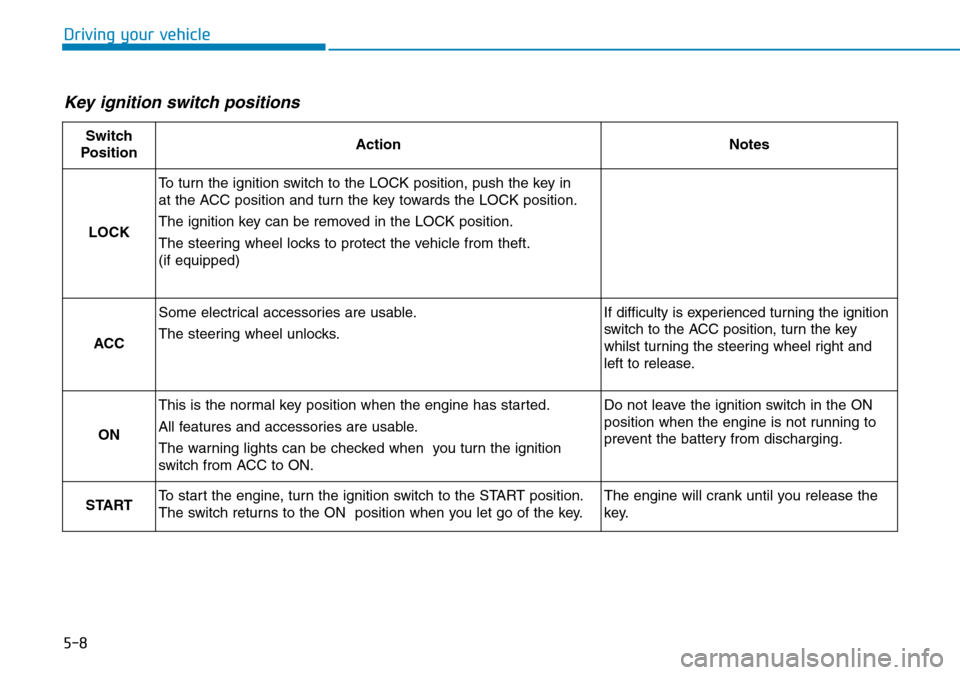
5-8
Driving your vehicle
Key ignition switch positions
Switch
PositionActionNotes
LOCK
To turn the ignition switch to the LOCK position, push the key in
at the ACC position and turn the key towards the LOCK position.
The ignition key can be removed in the LOCK position.
The steering wheel locks to protect the vehicle from theft.
(if equipped)
ACC
Some electrical accessories are usable.
The steering wheel unlocks.If difficulty is experienced turning the ignition
switch to the ACC position, turn the key
whilst turning the steering wheel right and
left to release.
ON
This is the normal key position when the engine has started.
All features and accessories are usable.
The warning lights can be checked when you turn the ignition
switch from ACC to ON.Do not leave the ignition switch in the ON
position when the engine is not running to
prevent the battery from discharging.
STARTTo start the engine, turn the ignition switch to the START position.
The switch returns to the ON position when you let go of the key.The engine will crank until you release the
key.
Page 342 of 682

5-13
Driving your vehicle
5
Engine Stop/Start button positions
- Vehicle with manual transmission
Button Position Action Notes
OFFTo turn off the engine, stop the vehicle and
then press the Engine Start/Stop button.
The steering wheel locks to protect the
vehicle from theft (if equipped).If the steering wheel is not locked properly when
you open the driver's door, the warning chime will
sound.
ACCPress the Engine Start/Stop button when
the button is in the OFF position without
depressing the clutch pedal.
Some electrical accessories are usable.
The steering wheel unlocks.If you leave the Engine Start/Stop button in the
ACC position for more than one hour, the battery
power will turn off automatically to prevent the bat-
tery from discharging.
If the steering wheel doesn't unlock properly, the
Engine Start/Stop button will not work. Press the
Engine Start/Stop button whilst turning the steering
wheel right and left to release.
Page 344 of 682
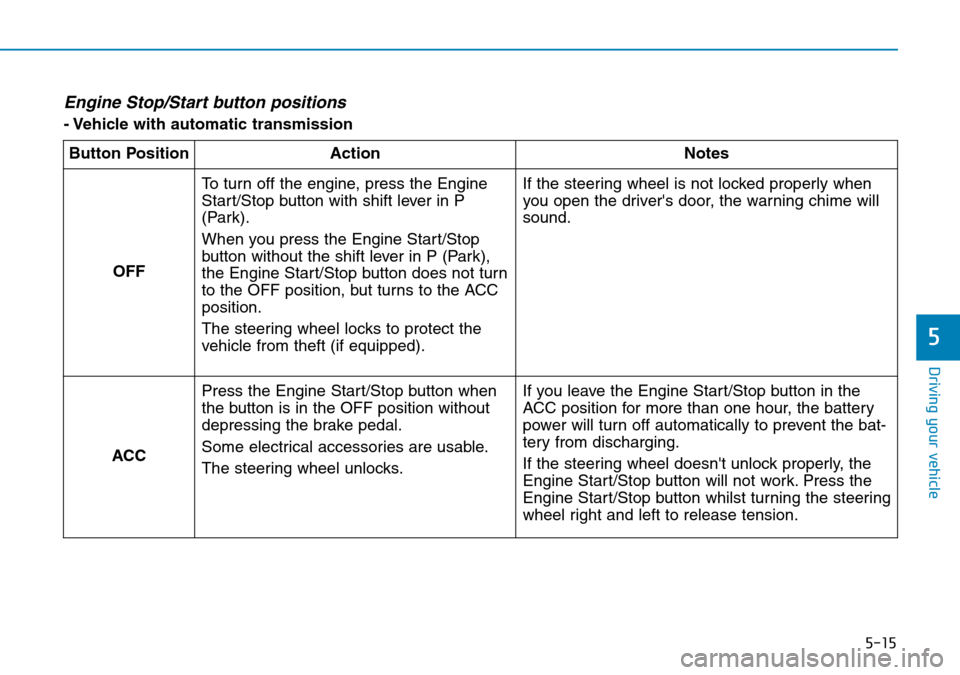
5-15
Driving your vehicle
5
Engine Stop/Start button positions
- Vehicle with automatic transmission
Button Position Action Notes
OFFTo turn off the engine, press the Engine
Start/Stop button with shift lever in P
(Park).
When you press the Engine Start/Stop
button without the shift lever in P (Park),
the Engine Start/Stop button does not turn
to the OFF position, but turns to the ACC
position.
The steering wheel locks to protect the
vehicle from theft (if equipped).If the steering wheel is not locked properly when
you open the driver's door, the warning chime will
sound.
ACCPress the Engine Start/Stop button when
the button is in the OFF position without
depressing the brake pedal.
Some electrical accessories are usable.
The steering wheel unlocks.If you leave the Engine Start/Stop button in the
ACC position for more than one hour, the battery
power will turn off automatically to prevent the bat-
tery from discharging.
If the steering wheel doesn't unlock properly, the
Engine Start/Stop button will not work. Press the
Engine Start/Stop button whilst turning the steering
wheel right and left to release tension.